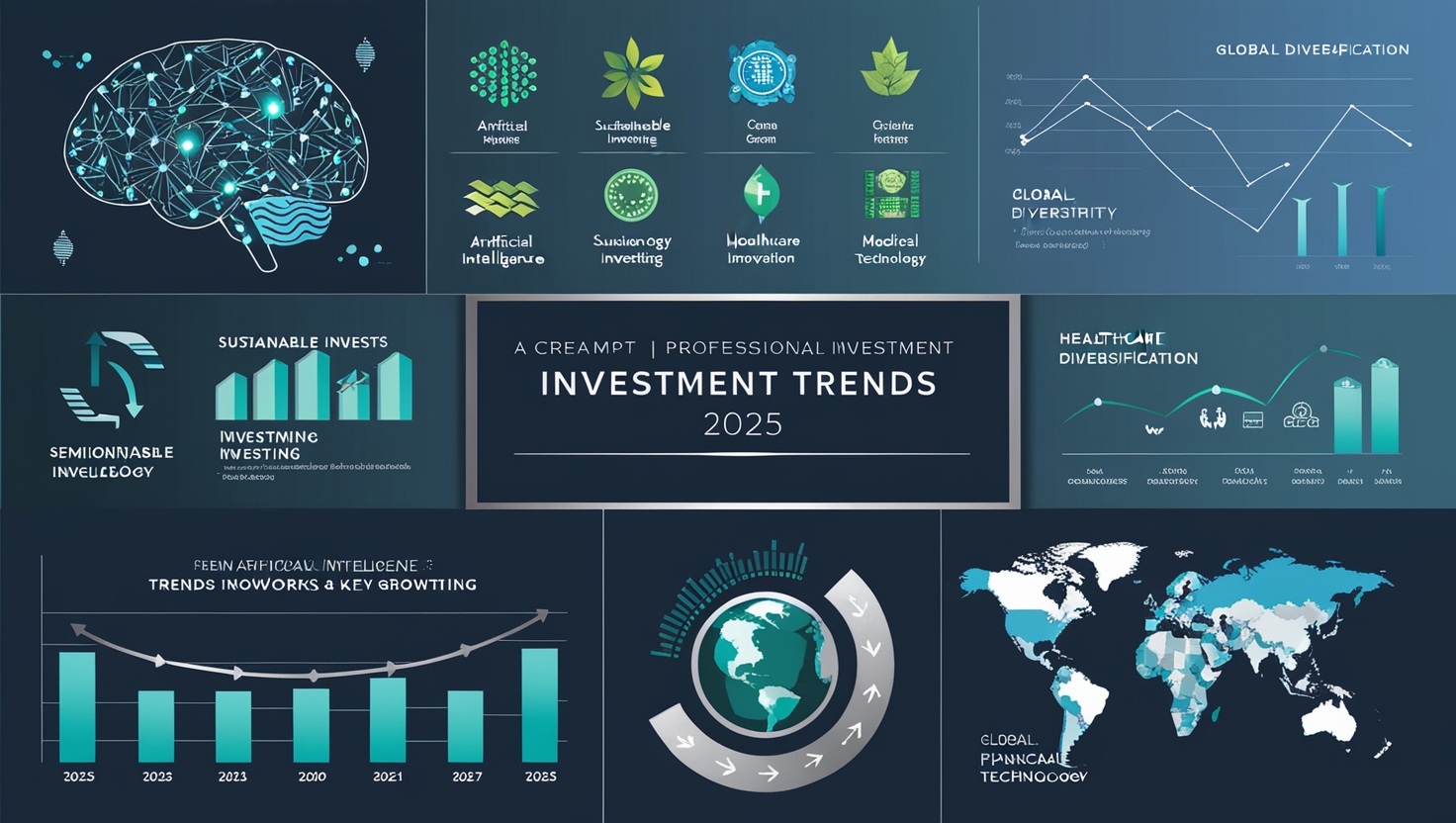The Investment Landscape in 2025: A Comprehensive Overview of Radical Developments
The investment world in 2025 is experiencing a historic transformation driven by accelerating technological developments and profound geopolitical changes. Projections indicate that global spending on artificial intelligence systems will experience annual growth of 19.1% through 2027, while markets face new challenges and opportunities requiring a rethinking of traditional investment strategies.
Financial markets in 2025 are influenced by multiple factors, including changing government policies, new regulations, trade agreements, and geopolitical tensions, affecting global growth and reshaping the international investment map. This development requires investors to remain agile and informed to successfully navigate these complex market currents.
Key Drivers of Change in 2025
Five main drivers define the current investment landscape:
- Persistent US Housing Shortage: Boosting real estate development opportunities with an estimated shortage of 2-3 million homes
- AI-Driven Energy Bottleneck: Spurring demand for new infrastructure investment
- Interest Rate Normalization: Though remaining elevated, setting the stage for more private equity dealmaking
- Rising Capital Investment: Supporting innovation after years of scarcity
- Private Credit Benefits from Normalizing Rates: Along with private equity
High-Yield Savings Accounts: Safe Haven for Investors
Why High-Yield Savings Accounts Top Investment Lists
High-yield savings accounts are considered the top choice for investors seeking safety and guaranteed returns in 2025. These accounts provide competitive interest rates with complete capital protection and immediate access to funds, making them ideal for emergency funds and short-term investments.
Key advantages of these accounts include:
- Complete Safety: Full protection from market volatility with government guarantee
- Instant Liquidity: Access to funds anytime without restrictions
- Competitive Returns: Interest rates that far exceed traditional accounts
- No Fees: Most of these accounts are free from administrative fees
- Easy Management: Advanced digital platforms for money management
CD Ladder Strategy
The CD ladder strategy is one of the smartest ways to maximize benefits from changing interest rates. This strategy involves distributing investments across certificates of deposit with staggered maturities, providing liquidity and reducing reinvestment risk.
The AI Revolution: The Fastest Growing Sector
Investment Opportunities in the AI Ecosystem
Artificial intelligence leads a new investment wave in 2025 with exceptional growth opportunities. Gartner indicates that global spending on AI systems will grow at 19.1% annually through 2027, creating golden opportunities for smart investors.
Investment opportunities in the AI sector diversify across the complete value chain:
| Sector | Investment Opportunities | Expected Growth Rate | Risk Level |
| Semiconductors | AI chip manufacturing companies | 25-30% annually | Medium to High |
| Data Centers | Digital infrastructure and cloud computing | 20-25% annually | Medium |
| Application Software | AI platforms and applications | 30-40% annually | High |
| Cloud Services | Computing and cloud storage platforms | 18-22% annually | Low to Medium |
Explosive Energy and Infrastructure Demand
The energy sector experiences tremendous growth driven by three main catalysts: US reindustrialization, increased electrification use in clean energy solutions, and accelerating adoption of AI and digital infrastructure. Studies expect US energy demand to grow 5-7 times over the next three to five years.
Alternative Investments: Portfolio Diversification and Return Maximization
Private Markets and Private Equity
Private markets experience strong recovery in 2025 driven by supportive market conditions and expectations of accommodative monetary policies. Demand is strong for private market strategies across both institutional and individual investors.
Top private market strategies include:
- Co-investments: Opportunities to invest alongside larger funds
- Large Buyouts: Acquiring established companies and developing them
- Secondary Markets: Purchasing stakes in existing funds at attractive discounts
- Growth Investments: Supporting companies in expansion phases
- Private Credit: Direct lending to companies with high returns
Infrastructure Funds: Investing in the Future
Infrastructure investments attract increasing attention from institutional investors and governments. Billions of dollars flow toward power grids, transportation networks, and digital infrastructure, making this sector a key focus for long-term economic growth.
Technology Sector: The Primary Growth Engine
Leading Technology Stocks and Startups
Technology remains at the forefront with AI, cloud computing, and big data continuing to drive innovation at an unprecedented pace. Industry giants like NVIDIA, Microsoft, and Apple continue investing heavily in AI infrastructure, positioning them for additional gains in 2025.
Technology stocks experience growth driven by several factors:
- AI Spending Surge: Companies prioritize investment in advanced computing power
- Semiconductor Sector Growth: Benefiting from increasing demand for AI processors
- AI-Powered Application Development: Rising demand for intelligent software
- Accelerating AI Adoption: Across diverse industries from e-commerce to automotive
CHIPS Act and Enhanced Domestic Production
The CHIPS and Science Act of 2022 enhances domestic semiconductor production, aiming to reduce dependence on foreign suppliers. This policy shift benefits companies like Intel and Taiwan Semiconductor Manufacturing Company (TSMC) investing in US production facilities.
Financial Sector: Benefiting from Favorable Economic Environment
Banking and Payment Services in a New Digital Era
The financial sector is set to benefit from a favorable economic backdrop in 2025, with steady growth, potential interest rate cuts, and a pro-business environment. These factors create opportunities across banking, insurance, and payment services.
Key drivers of financial sector growth:
- Enhanced Lending: Lower interest rates stimulate credit activity
- Reduced Credit Risk: Improved economic conditions reduce loan defaults
- Flexible Regulatory Environment: Encouraging mergers and acquisitions
- Digital Payment Services Growth: Shift toward electronic payments
- Financial Technology Innovation: New solutions for banking services
Industrial Sector: Benefiting from Global Restructuring
Infrastructure, Manufacturing, and Aerospace
The industrial sector enters 2025 with strong momentum, driven by rising infrastructure investment and the push to revitalize domestic manufacturing. Governments worldwide commit significant funding to large-scale projects, while advances in automation and AI-driven logistics improve efficiency across industries.
Promising subsectors include:
- Aerospace and Defense: Continued growth with increasing defense budgets
- Advanced Manufacturing: Benefiting from acts like the Inflation Reduction Act and CHIPS Act
- Construction and Electrification: Growth driven by infrastructure projects
- Transportation and Logistics: Smart transportation network development
Healthcare Sector: Investing in Future Health
Medical Innovation and Health Technology
The healthcare sector represents a key opportunity area in 2025, with expectations to benefit from rising global demand for medical services, aging population, and ongoing innovation in pharmaceuticals, biotechnology, and medical devices. As medical advances continue reshaping treatments and improving patient outcomes, the sector is well-positioned for sustained growth.
Promising healthcare investment areas:
| Area | Key Developments | Investment Opportunities |
| AI Diagnostics | Medical imaging analysis and early diagnosis | Medical algorithm development companies |
| Biotechnology | Gene therapy and personalized medicine | Innovative pharmaceutical companies |
| Medical Devices | Wearable devices and remote monitoring | Medical technology developers |
| Digital Health | Telemedicine and virtual care | Digital healthcare platforms |
Energy Sector: Transition to a Sustainable Future
Renewable Energy vs. Fossil Fuels
The energy sector is expected to be one of the strongest performers in 2025, with shifting market dynamics creating significant opportunities for investors. A renewed focus on fossil fuels, alongside ongoing demand for renewables, has positioned the sector for strong returns.
Recent developments in the energy sector:
- Investment Redirection: Major energy companies scaling back renewable energy investments
- Increased Oil and Gas Production: Redirecting capital toward hydrocarbons
- Pro-Fossil Fuel Policies: Encouraging oil and gas investment
- Continued Renewable Growth: Despite shifts, investments in wind, solar, and batteries remain
Clean Energy and Storage Investments
According to an S&P Global Commodity Insights report, clean energy technology investments are set to exceed oil and gas spending for the first time, with cleantech energy supply spending projected to reach $670 billion in 2025. Solar photovoltaic is expected to account for half of these investments and two-thirds of installed megawatts.
Cryptocurrencies and Digital Assets: Maturity and Stability
Evolution of Cryptocurrency Investment Trends
Cryptocurrency investment trends advance in 2025 with regulation stabilization and rising opportunities. Real asset tokenization, increased blockchain adoption, and the rise of stablecoins reshape how investors engage with digital assets.
Key trends for cryptocurrency investors:
- Crypto-backed Financial Products: Banks and asset managers expand investment vehicles tied to digital assets
- Growing Stablecoin Adoption: Seeking alternatives for payments and wealth preservation outside volatile cryptocurrencies
- Smart Contract Application Growth: Blockchain technology improvements in real estate transactions, DeFi platforms, and tokenized assets
Real Estate Investment: Capitalizing on Global Shortages
US Housing Crisis as Investment Opportunity
The US housing market creates structural opportunities for real estate investors globally. With an estimated shortage of two to three million homes in the United States, demand for housing far outstrips supply, and new real estate development has become a pressing social need.
Types of promising real estate investments:
- Residential Development: Building new homes to address shortage
- Multifamily Apartments: Long-term rental investments
- Senior Housing: Growing sector with aging population
- Workforce Housing: Housing for middle-income workers
- Industrial Real Estate: Warehouses and distribution centers
Real Estate Investment Trusts (REITs)
REITs and listed infrastructure companies provide liquid exposure in logistics and transportation sectors. These instruments enable investors to invest in massive commercial real estate with relatively small amounts, with regular dividend distributions and capital growth potential.
Sustainable Investments and ESG: The Green Future
Growth of Environmental, Social, and Governance Investments
Sustainability remains central to market trends, with green bonds and ESG investments driving capital flows. Studies indicate that nearly 70% of asset owners believe ESG factors have become more important over the past five years.
Promising sustainable investment areas:
| Sector | Investment Focus | Expected Growth |
| Renewable Energy | Solar and wind power | 15-20% annually |
| Energy Storage | Batteries and smart grids | 25-30% annually |
| Electric Transportation | Electric vehicles and charging stations | 20-25% annually |
| Green Buildings | Sustainable construction technologies | 12-18% annually |
Risk Management and Diversification: Keys to Investment Success
Importance of Portfolio Balance
With all asset classes soaring, it's important to maintain a measured attitude and resist the temptation to engage in emotional trading driven by fear of missing out. Staying agile and informed will be key to navigating these market currents in 2025.
Effective risk management strategies:
- Asset Class Diversification: Stocks, bonds, real estate, and commodities
- Geographic Diversification: Domestic and international developed and emerging markets
- Sector Diversification: Different sectors with varying risk levels
- Temporal Diversification: Short, medium, and long-term investments
- Periodic Rebalancing: Regular portfolio review and adjustment
Emerging Challenges and Risks
Investors in 2025 face new challenges requiring constant vigilance:
Investment success is measured not only by achieved returns, but also by the ability to avoid large losses and preserve capital during uncertain periods
- Persistent Inflation Risks: Impact on purchasing power and real returns
- Geopolitical Volatility: International tensions and trade wars
- Technology and Cybersecurity Risks: Protecting digital investments
- High Valuation Risks: Potential bubbles in some sectors
Conclusion: Building a Prosperous Financial Future in an Era of Transformation
The year 2025 offers diverse and exciting investment opportunities requiring smart investors to have deep understanding of changing market dynamics and follow well-studied and balanced strategies. From the AI revolution reshaping industries, to enormous opportunities in real estate and renewable energy, options vary to suit all risk and return levels.
The key to investment success in this evolving era lies in smart balance between opportunities and risks, thoughtful diversification across sectors and geographic regions, and patience with long-term investments while maintaining flexibility to adapt to rapid changes. Investors who combine deep knowledge with investment discipline and strategic vision will be best positioned to achieve their financial goals and build sustainable wealth in this era full of opportunities and challenges.
Remember that successful investing is not merely chasing quick returns, but a long journey requiring continuous learning and adaptation to developments, and most importantly, maintaining a clear vision of your long-term financial goals and commitment to a sound investment plan that ensures you reach financial independence and prosperity in the future.




